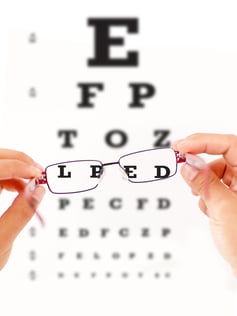How To Understand Compensated Prescriptions For Patient's Lenses

Lens technology continues to grow along with the needs and wants of our patients. More of them are seeking the best vision possible out of their lenses. While high end, compensated lenses more than fill their needs. They have also become viewed by many as a necessary evil. I believe with better understanding, almost all will see them as a necessary good with a few minor drawbacks.
The very little "bad" with compensated prescriptions is solely based upon a total lack of understanding. Anyone working with outside prescriptions has the concern that a re-check of the glasses will result in the doctor’s office telling your patient that the Rx is not correct. Sharing some of your knowledge with them would go a long way in putting this issue behind us.
There has also been some pushback out of fear that we are changing the Rx written by the doctor. This could not be further from the truth! Compensated prescriptions assure that your patient gets the prescribed power at the center of the lens in the position of wear.
When a doctor writes an Rx, he or she is not telling you to place a lens on the patient that shows the power on a lensmeter. They are looking for more out of you. They are wanting you to give their patient a lens that has the effect of combining the prescribed powers with the optical powers of the patient’s visual system. One prime example is digital processing which gives us the ability to utilize compensated power to overcome the power shift that occurs when the fitting vertex does not match the refracting vertex.

This is very similar to the Rx difference found between a contact lens prescription and an eyeglass lens prescription. The difference between these 2 prescriptions is simply the vertex difference.
In days past, an optometrist could have written a specific “compensated” Rx specifying base curve, wrap angle, pantoscopic tilt, and vertex distance. Then your job would have been very difficult to find a frame that fit these specific measurements that the patient actually liked. We would have not known what to do with this.
Fast forward to today, where we have computer systems and digital surfacing. This technology allows us to reverse engineer the frame fit and create a fully compensated pair of lenses. Through all sorts of crazy magic and voodoo, we can actually produce a pair of lenses that allow your patient to see the exact Rx which the doctor has prescribed.
To fully understand the need for compensation, take a -4.00 sphere stock SV and clamp it in your lensmeter. Bingo! It reads -4.00 sphere. Now loosen the clamp and tilt the lens a bit. Shazam! That perfect -4.00 power now has a cylinder. It might even have a weaker or stronger sphere power and could even show some prism.
A prescription lens power changes depending on how light flows through it. This is the "slop" that compensated prescriptions are designed to fix. The lens you dispense to your patient will seldom be worn in the same position as the lens used in refraction.
In the past, we sacrificed straight-ahead vision because of the power changes induced by the fit of the frame. Tilt, wrap, and vertex distance changes when compared to the lens position during refraction. This causes adaptation issues and often required Rx changes needlessly.
When we talk about compensated prescription, keep in mind that we are speaking only of the performance found in the optical center in single vision lenses or the distance reference point of progressive lenses. The rest of the voodoo done to minimize peripheral aberrations is done through digital design and that's another blog for another day.

By utilizing this advanced technology, you will be giving your patient a lens that actually performs as prescribed. This will result in fewer remakes, less adaptation time and a happier, more satisfied patient.
Giving your patient the prescribed power at the center of the lens through compensation is the springboard to assuring that the voodoo being done in the periphery is also going to work. This is what makes ultra-premium lenses ultra-premium.
You do not need to use the “as worn” measurements such as vertex, wrap, and panto. The estimates used by lens designers will be within 5% of correct over 90% of the time. Proper frame adjustment is important with these designs. Make sure your patients know to keep them adjusted for optimum visual performance.
Most patients are not looking for the cheapest pair of lenses you can supply. Most are looking for the best vision possible and value. Compensated designs will give your patients a value product and in most cases, the best pair of lenses they have ever worn.
For more information on all of the compensated prescription lens offerings available at IcareLabs, head over to our Resource Center for all of your ECP needs.

